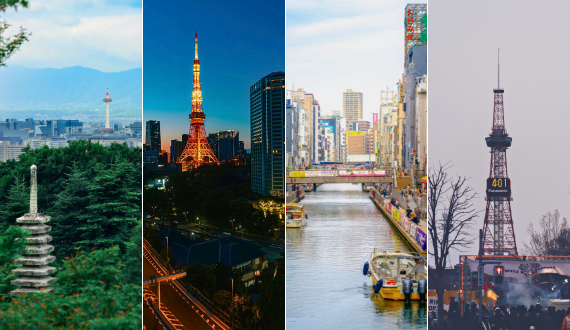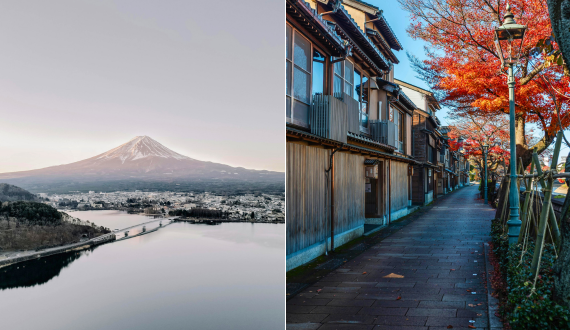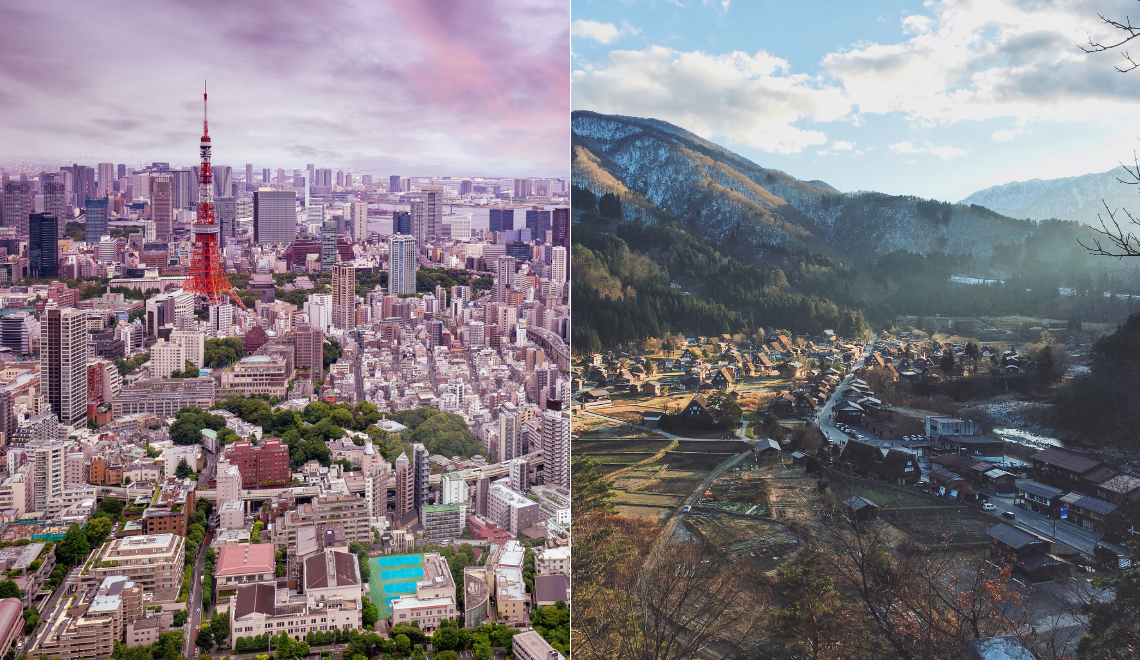Choosing where to live in Japan is a personal journey. As a foreigner living in Japan full-time, you’ll want to weigh daily comforts, community, and costs. Are you looking to move to Japan, living in Japanese cities like Tokyo or Osaka, or enjoy the peace and quiet of a mountain town in Nagoya or Kyoto away from it all? Maybe something in between urban and rural is more your speed where the cost of living in Japan is incredibly affordable.
The “best place to live in Japan as a foreigner” depends on YOUR priorities: urban convenience, suburban balance, semi-rural charm, or countryside calm.
In this quick comparison guide, we’ll build off our Property Market Guide and explore each of the following lifestyles, focusing on pace of life, amenities, transport, culture, community, and housing within:
- Urban Japan (Tokyo, Osaka, Fukuoka, Yokohama, Sapporo, Kyoto)
- Suburban Japan (Chiba, Saitama, Machida, Kobe, Yokosuka)
- Semi-rural Japan (Shizuoka, Matsumoto, Beppu, Yamanashi, Kanazawa)
- Rural Japan (Tottori, Akita, Kochi, Shimane, Aomori)
From the best cities throughout Japan to the Japanese culture laden, affordable living of rural Japan, let’s get look at life in Japan and discover the best place for you!
City Life: Urban Japan – Tokyo, Osaka, Yokohama, Fukuoka, Sapporo, Kyoto

Atmosphere & Lifestyle:
Urban Japan is almost surreal. Some of the best cities in Japan like Tokyo, Osaka, or Fukuoka are always switched on, with pockets of things happening day and night, offering something for everyone. Shopping, dining, entertainment — they’re all right outside your door, literally. Trains are on-time every few minutes, letting you live without a car and still cross town in minutes. You get everything you want, everything you need, and then some more still, yet, the trade-off is pace. City life is fast and often exhausting. Long workdays and crowded commutes are routine. While networking is easy, forming deeper local friendships takes time. A lot of expats will tell you from experience that life in the city can feel paradoxically isolating, even with millions of people around.
Community & Culture:
Urban areas are cultural melting pots. You’ll find plenty of foreigners and international groups. Living in Tokyo, the largest city in the world, or Osaka, there are countless expat bars, meetups, and networking events that let you explore your interests and connect with others (at least on the surface). Nearly everyone is polite, but they’re also busy. English signage and international schools are everywhere, and although there are more English speakers in Japanese cities, you’ll still need to learn Japanese at a basic level if you want to get anything close to the full experience.
Amenities & Convenience:
With big cities like Tokyo, Osaka, and Kyoto, quite literally everything is at your fingertips: clinics, parks, cafes, schools, entertainment, even world class, cutting edge experiences. Emergency response times are fast. Public transport is world-class, except for a few taxis. They can drive pretty wild! All this convenience comes at a cost, though. A one-bedroom apartment in central Tokyo typically ranges from ¥150,000–¥250,000 per month. Osaka is less expensive than Tokyo but is still far pricier than what you’d pay outside a metro. Space is tight too, with the average home in Tokyo being around 90 m² (affordable ones being closer to 60m²), about half the size of the average home in the rest of Japan.
Healthcare & Services:
Urban areas offer the most access to hospitals, clinics, and English-speaking specialists. Even in bigger cities like Kyoto, Tokyo, and Osaka, not every support staff is an English-speaking employee, but there’s always someone who can help. Cell coverage and internet are fast and reliable, in fact, it ranks among the best globally.
Summary – Urban Japan
- Pros: Endless convenience, international options, strong job market, excellent public transit.
- Cons: High living cost (relative to other parts of Japan), small living spaces, crowded commutes, social disconnection unless you’re proactive.
Suburban Japan – Chiba, Saitama, Kobe, Machida, Yokosuka
Atmosphere & Lifestyle:
Suburbs offer that typical middle ground. Imagine a place quieter than the city in Japan but close enough for a daily commute, either by car or train. Life here is calmer, slower, and a little greener. Places like Saitama (close to the capital of Japan, Tokyo), Chiba (close to Tokyo), or Yokosuka (close to Yokohama) offer a relaxed pace and are tailor made for families. You’ll find playgrounds, schools, large supermarkets, lower building density, and beautiful cherry blossom areas. The suburbs are a place in Japan for couples raising kids or professionals looking to balance work with space and normality.
Housing & Cost:
Detached homes, small gardens, and multi-story houses are more common. Rents drop significantly the farther you move from the city core. One-bedroom apartments in areas like Machida or Saitama might range from ¥50,000 to ¥80,000 per month. Buying land or a home here is more accessible, and you’ll get noticeably more space for your yen.
Community & Culture:
These neighborhoods feel more residential and friendly; folks are more likely to say hello, while small omatsuri (festivals), neighborhood clean-ups, and PTA meetings are regular events. Some suburbs have strong expat communities like Yokosuka, for example, has a well known, large American presence due to the naval base. Other towns, like Machida or Kobe, have welcoming atmospheres.
Practicalities:
Public transport is still reliable, though commutes might stretch to 45 minutes or longer. Some daily errands may require a car. English-language services are fewer than in city centers, but basic amenities such as clinics, banks, and government offices are well covered. It’s a manageable and comfortable compromise that makes for a great standard of living.
Summary – Suburban
- Pros: Lower housing costs, more space, family-friendly, still connected to urban centers, reasonable cost of living.
- Cons: Longer commutes, fewer international amenities, and more Japanese-only environments.
Semi-Rural Japan – Shizuoka, Matsumoto, Beppu, Yamanashi, Kanazawa

Atmosphere & Lifestyle:
Welcome to the “best of both worlds.” I’m a bit biased since I’m from a semi-rural town myself, but these towns are often overlooked gems. You’ll find mountains, rivers, and open skies, but also supermarkets, theaters, good schools, and a train station that can get you to a major city. In towns like Kanazawa or Matsumoto, you can bike to a castle in the morning and shop in a modern mall in the afternoon. This type of area might be one of the best places with its lower living costs and traditional Japanese living.
Amenities:
You’ll have everything you need, but only one, maybe two of each. For example, there may be one large hospital instead of ten, and a couple of grocery stores instead of a dozen. Internet is fast, 5G is rolling out quickly, and fiber is already in most towns which makes teaching English online a great option. It’s a very livable middle ground with its lower cost of living.
Community & Culture:
This is where you’ll start experiencing deep local flavor. Expect neighbors to greet you regularly, kids to trek a good distance to school by themselves, and local matsuri that last all weekend. Foreigners are rarer, but often warmly welcomed. Towns like Beppu and Kanazawa have a surprising number of international students or tourists, which helps soften the cultural transition.
Housing & Property:
Homes are larger, often with gardens and outbuildings. You can rent or buy a full house for the price of a Tokyo one-bedroom. Monthly rent is usually between ¥30,000–¥70,000 per month or purchase prices below ¥20 million. Renovation projects are common, and zoning is even more flexible. If you’re looking to start a small business, farm, or renovate a home, this is your playground, especially for those areas with grants inviting you to do so. This is also where you start to find some more unique property.
Summary – Semi-Rural
- Pros: Scenic views, slower lifestyle, close-knit communities, larger homes, cheaper prices, great cost of living.
- Cons: Limited nightlife, car dependency, fewer job opportunities unless remote work is an option.
Rural Japan – Tottori, Akita, Kochi, Shimane, Aomori
Atmosphere & Lifestyle:
This is Japan at its most peaceful and traditional. Expect quiet nights, starry skies, and deeper seasonal living. Rural towns offer fresh food, strong traditions, and an abundance of space. Some people say time moves slower here — and that’s not a bad thing. Both mainland Japan and its outlying islands have rural areas that may be the place to call home.
Amenities & Services:
There may be only one hospital for miles, and train service might come once per hour (or not at all). A car is a must, stores close early, and variety is limited. That said, you’ll get some of Japan’s best nature. Activities like skiing, hiking, surfing, and onsen are everywhere.
Community & Culture:
Things in rural Japan are without a doubt more personable. Everyone knows everyone. Even if they don’t know your name, they know of you. If you attend the summer festival, you’ll be noticed (and probably invited back). That said, there’s a major caveat. Japanese language ability is key here, and cultural integration happens slowly, albeit meaningfully. Social life centers around temples, festivals, and neighborhood events.
Housing & Property:
Prices are incredibly low. A three-plus room home with land (like, a whole forest) might cost under ¥10 million, or even be offered for free or with government grants via akiya programs if you agree to renovate. You’ll also find some truly unique homes across a long timeline of build dates. Space is abundant, but the flip side is responsibility: you’ll likely need to handle your own snow clearing, gardening, maintenance, things of that nature.
Summary – Rural
- Pros: Unmatched peace, nature, huge homes, generous communities, ultra-low property prices, great cost of living.
- Cons: Isolated, car-dependent, limited services, slow integration unless you speak Japanese or commit long-term.
Finding Your Fit
Alright. There’s urban, suburban, semi-rural, and rural. Think about how you want to spend your mornings. What do you want to see out your window everyday? Consider the amount of noise, space, and connection you want (or don’t want).
- Choose Urban if you thrive on energy, career access, and global connections.
- Choose Suburban if you value a family-friendly mix of comfort and access.
- Choose Semi-Rural if you want community, affordability, and space—without giving up convenience.
- Choose Rural if you seek deep quiet, natural beauty, and long-term immersion with Japan.
The good news? Wherever you choose to live in Japan, foreign buyers can own land and property outright with no citizenship requirement. Whether it’s a Tokyo condo or a cottage in Kochi in southern Japan, your dream lifestyle is possible, and with how affordable property is here, you might consider a primary residence with a vacation home elsewhere!
Match your vision to the right place. Japan has more housing options than most countries — and it might just have one waiting for you.

